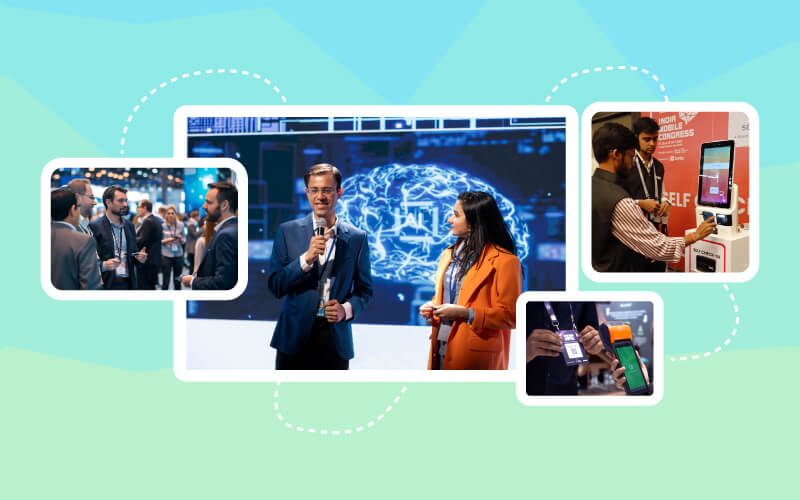Every day, thousands of events worldwide deliver to diverse audiences, featuring various themes to cater to a range of objectives and goals. However, the question remains: How to evaluate whether all these goals and objectives have been fulfilled? How to measure the Key Performance Indicators (KPI’s) and find the areas to improve your event strategies to enrich the attendee experience. All of this is connected with one key aspect which most of us do not give much importance to, that is post event analytics. Here in this blog, we are going to explore the importance of post-event activities, how to do surveys, the checklist to follow, tips and other crucial aspects to consider. So, without further ado, let’s get started;
Why Do Post-Event Analytics Matter?
Post-event analytics hold significant importance as they provide detailed insights into event performance and attendee engagement. By evaluating the post-event data, organizers can gain a thorough understanding of attendee behavior, preferences, and overall satisfaction levels. Additionally, various data points such as KPIs, revenue collection, attendee data, and more can be utilized for further marketing and other purposes. This valuable data collection enables hosts to identify various aspects for improvement, as well as assess the success of the event’s impact on attendees.

Key Deliverables of Post-Event Analysis
There are many key aspects that a post event report unveils. Here are the top 8 pointers, but it is not limited to this;
- Measure Event Success
- Identify Strengths and Weaknesses
- Understand Attendee Satisfaction
- Optimize Resource Allocation
- Enhance Content and Post Event Management
- Improve Marketing Strategies
- Identify Trends and Opportunities
- Inform Strategic Decision-Making
- Assess Return on Investment (ROI)
- Unveils Benchmark Performance
Types of Post-Event Analysis Reports
There are many types of reports after the event has been prepared based on the post-event follow-ups, engagement, pre-event registration, interactions, social media, and more. Every post-event activities report is somewhat necessary to explore the wide range of factors that contribute to the success of the event. So, here are some of the core types of after-event analysis reports;
Attendance Analysis: Whether your event is organized on-ground or in a virtual setting. The number of attendees participating is important. Besides that, knowing their demographics helps to understand the reach and audience composition.
Session Engagement: In an event, there might be many sessions running simultaneously. Noting the participation rates of each session tells the effectiveness of content and preferences. These insights are for improving the session topics for speakers and other factors.
Feedback Surveys: Thoroughly analyze the survey responses to evaluate the attendee satisfaction levels and they’re saying how they feel as well as their suggestions. The feedback is critical as it expresses the real point of areas attendees liked or disliked at your event.
Revenue and ROI Assessment: For the host, it is a must-know aspect to get the proper report about the ROI. To check the event profitability. The revenue assessment helps to make the budget for the next event while all other aspects shorten the expense.
Social Media Analytics: In the digital era, social media is an important factor, note the post event engagement metrics, posts on #hashtags, tags, live streaming views, comments, and more. This gives digital marketing outlooks.
Technology Performance Analysis: Evaluate the effectiveness of event technology tools and platforms to streamline future technology integration. Utilize technology insights to enhance attendee experiences and improve event operations.
Some Other Types of Post-Event Analysis Reports

Lead Generation Tracking: Monitor leads generated during the event and track conversion rates to evaluate business outcomes. Utilize lead data to refine lead nurturing strategies and capitalize on potential opportunities.
Sponsorship Evaluation: Assess the visibility and impact of sponsorships to inform future partnership strategies. Utilize sponsorship insights to enhance sponsor ROI and strengthen partnerships for future events.
Post-Event Interviews: Conduct interviews with key stakeholders to gather qualitative insights and feedback. Extract valuable insights to inform strategic decisions and enhance future event planning efforts.
Comparative Performance Review: Compare event performance against previous editions or industry benchmarks to identify trends and areas for improvement. Utilize comparative analysis to drive continuous improvement and elevate future event experiences.
Moreover, it is also important to understand the strategies needed to be prepared for the post-event activities. Here next let’s deep dive into the core strategies, survey forms and other crucial tips to consider;
Activities for Effective Post-Event Analysis
After the event has happened all your audience went to their respective places. This is the time to push all your post-event activities. Deploying fine strategies can enable the organizers to glean valuable insights to enhance future event experiences.
Data Collection and Organization
Collecting data is the first and the most crucial step. By gathering a diverse range of data points including; attendee registration information, session attendance, feedback surveys, social media metrics, and other relevant data. After collecting this data, it’s crucial to systematically organize it to facilitate easy interpretation.
Performance Evaluation
Once you collected the data and systematically arranged it. It is time to evaluate the key performance indicators (KPIs) that measure the success of the event. These assessing metrics consist of overall attendance rates, session engagement levels, revenue generated, and any other relevant performance metrics. By comparing the results you got from the expected goals. Organizers can determine the event’s effectiveness and identify areas for improvement.
Trend Analysis
It is always important to know the industry’s latest trends and practices. Analyzing the collected data enables the determination of trends, such as audience preferences and behavioral analytics. By identifying these patterns and trends, understanding the audience in a deeper sense can be possible. This insight can correct upcoming event planning, letting organizers customize their offerings to better meet attendee expectations and maximize engagement.
Survey Tips and Post-Event Checklist for Enhanced Event Insights
There are many tips or ideas which can be used to plan and execute but some of them are crucial to acknowledge. Here are some of the best tips you can rely on.

Survey Tips for Gathering Actionable Insights
Crafting Effective Surveys: Ensure clarity and brevity in survey questions, blending closed and open-ended formats to capture quantitative and qualitative data. Thoughtful wording encourages meaningful responses.
Timely Distribution: Dispatch surveys promptly after events to capture fresh perspectives while memories are vivid. Reminders can boost response rates, ensuring comprehensive feedback for analysis.
Incentivizing Participation: Offer incentives like discounts, prize entries, or exclusive content to motivate survey completion. Emphasize the value of feedback in shaping future events to encourage active participation.
Analyzing Responses: Thoroughly analyze survey data to unearth trends, patterns, and improvement areas. Delve into attendee perceptions and preferences to inform strategic decisions for upcoming events.
Post-Event Checklist for Comprehensive Analysis
Data Compilation: Gather all event-related data, including registrations, attendance records, survey responses, and social media metrics. This holistic dataset lays the groundwork for insightful analysis.
Conducting Analysis: Dive deep into data analysis, scrutinizing key performance indicators against predefined goals. Identify trends and patterns to understand event success and areas for enhancement.
Feedback Review: Scrutinize attendee feedback from surveys, reviews, and social media. Gain insights into satisfaction levels, preferences, and improvement opportunities to refine future event planning.
Action Item Identification: Pinpoint actionable insights from data analysis and feedback review. Adjust event logistics, content, or marketing strategies based on these findings to drive continuous improvement.
Implementing Improvements: Execute necessary enhancements derived from post-event analysis. Refine strategies, update processes, or introduce new initiatives to elevate attendee experiences and ensure event success. Continuously iterate to deliver maximum value to attendees and stakeholders alike.
End Note
In short, post-event analytics is one of the major components of successful event planning and execution. Sending personalized feedback forms to conducting surveys helps in knowing the event performance in a better way. Not only that, but it also helps in driving continuous improvement of events. As with the collected data and feedback, organizers can create more impactful and memorable events. If you are also looking forward to solutions that can help you collect feedback and conduct post-event analysis. We are here to help you with our Event CRM, WhatsApp automation, and mobile event app. All this can be an easier task. Book your free demo and get all queries resolved.







